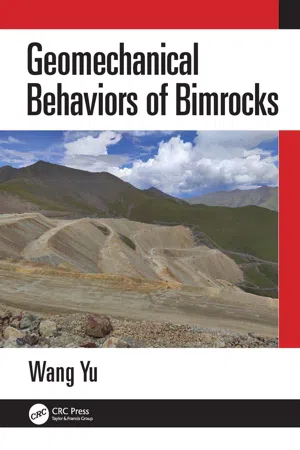1.1.1 Introduction
Bimsoils (block-in-matrix soils) are defined as structurally complex mixtures composed of stiff blocks of various lithologies and sizes, embedded in a fine-grained soil matrix (Lindquist, 1994; Kalender et al., 2014; Wang et al., 2017, 2018; Mahdevari and Maarefvand, 2017). Due to their complex origin and formation, typical bimsoils consist of opencast dumps, cemented waste backfills, weathered rocks, coarse pyroclastic rocks, mélanges breccias, colluvium and glacial tills, etc. Bimsoils are composed of randomly distributed rock blocks separated from the soil matrix by their contacts that are even weaker than the matrix. This kind of geomaterial is distributed all over the world and often represents a challenge in engineering practice. The ever-increasing importance of bimsoil in the geotechnical engineering construction has drawn more and more attention of many engineers in recent years. In the literature, this kind of special inhomogeneous geomaterial is also commonly referred to as block-in-matrix rocks (bimrocks) (Lindquist and Goodman, 1994; Coli et al., 2011, 2012; Afifipour and Moarefvand, 2014; Kahraman et al., 2015) or SRM (soil and rock mixture) (Xu et al., 2011; Zhang et al., 2015, 2016; Wang et al., 2016) or RSA (Rok and soil aggregate) (Li et al., 2004; Wang et al., 2014). Bimsoils are chaotic units, and there is a sufficient mechanical contrast between the weak soil matrix and stiff rock blocks. The shear characteristics, in fact, are strongly influenced by the geomechanical properties of the soil matrix and rock block percentage (RBP), as well as distribution, orientation, and block size.
Due to the importance of the shear strength of bimsoils in the construction and building structures, many scholars have conducted large-scale in situ direct shear tests (Chu et al., 1996; Coli et al., 2011; Xu et al., 2015), large-scale triaxial experiments (Chu et al., 2010), small-scale laboratory tests (Lindquist and Goodman, 1994; Wang et al., 2015, 2016), and numerical simulation methods on artificial or natural bimsoils. The large-scale in situ test, without disturbance of bimsoil samples, is a better way to determine the shear strength of bimsoils, but the cost is relatively high. Alejano and Carranza-Torres (2011) used penetrometer and vane tests to empirically estimate the shear strength of a bimsoil with the rock blocks of decomposed granite. Coli et al. (2011) conducted in situ shear tests on rocks composed of clayey matrix and rock fragments, which is named bimrock (Medley, 1994). The bimrock is characterized by a high friction angle and low cohesion. Chang and Cheng (2014) proposed a method to estimate the shear strength of gravel deposits by determining their topographic characteristics, which are the envelopes of slope inclinations and slope heights, and their study established an economic way to estimate the shear strength of bimsoils in Central Taiwan. Zhang et al. (2015) conducted in situ direct shear tests to bimsoils composed of embankment dam; the shear strength parameters were determined using the tests. By performing in situ shear experiments on large-scale bimsoil samples, Li et al. (2004) and Xu et al. (2011) obtained similar results: there is a decrease in cohesion and an increase in the friction angle with increasing RBP. Because of the high cost of in situ shear test, small-scale and large-scale triaxial experiments have always been an alternative method to determine the shear strength parameters. Donaghe and Torrey (1985) determined the shear strength of bimsoils using triaxial tests on large-scale samples and found that the effective friction angle increased with increasing gravel contents. Lindquist and co-workers performed laboratory triaxial deformation test on artificial bimsoil samples and found that the friction angle increases with increasing block content (Lindquist, 1994; Lindquist and Goodman, 1994; Medley and Lindquist, 1995). They also found that the block orientation has an obvious effect on the cohesion value. Other researchers also concluded that the shear strength of clay–rock mixtures gradually increases with increasing percentages of floating particles in unsaturated clays (Iannacchione, 1997; Vallejo and Mawby, 2000; Vallejo, 2001; Kokusho et al., 2004). Dupla et al. (2007) also indicated that the volumetric proportion of gravels is the main factor that influences the elastic and failure behaviors of bimsoils. Wang et al. (2016) performed a real-time ultrasonic test to investigate the ultrasonic and mechanical properties of bimsoil samples and found that the RBP influences not only the failure morphology but also the strength parameters. The results of physical modeling test and numerical simulation meth...
